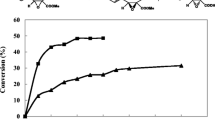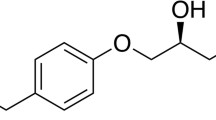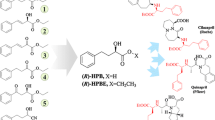Abstract
The enantiomers of (4R/S)-4-hydroxy-N, N-diphenyl-2-pentynamide are key chiral synthons for the synthesis of thrombin receptor antagonists such as vorapaxar. In this paper, we report the enzymatic preparation of enantiomerically enriched (4R)-4-hydroxy-N, N-diphenyl-2-pentynamide using lipase A from Burkholderia cepacia ATCC 25416 as the catalyst. First, the lipase gene (lipA) and its chaperone gene (lipB) was cloned and expressed in Escherichia coli system. After purification, lipase A activation was performed with the assistance of foldase lipase B. Enzyme assay revealed that the activated lipase A showed the optimal catalytic activity at 60 ºC and pH 7. The effects of various metals on the activity were investigated and results demonstrated that most of the metals inhibited the activity. To further improve the catalytic outcome, two-phase reaction was studied, and n-hexane proved to be a good organic solvent for the combination system. Using the optimize conditions, (4R)-4-hydroxy-N, N-diphenyl-2-pentynamide with 94.5% ee value and 48.93% conversion ratio was achieved. Our investigation on this lipase reveals lipase A as a promising biocatalyst for producing chiral propargyl alcohol for preparation of novel himbacine analogs.







Similar content being viewed by others
References
Bailey AL, Campbell CL (2011) Oral antiplatelet therapy for acute coronary syndromes: aspirin, P2Y12 inhibition and thrombin receptor antagonists. Curr Drug Targets 12:1805–1812
Chackalamannil S (2006) Thrombin receptor (protease activated receptor-1) antagonists as potent antithrombotic agents with strong antiplatelet effects. J Med Chem 49:5389–5403
Chelliah MV et al (2014) Himbacine-derived thrombin receptor antagonists: c7-aminomethyl and c9a-hydroxy analogues of vorapaxar. ACS Med Chem Lett 5:183–187
Clasby MC et al (2007) Metabolism-based identification of a potent thrombin receptor antagonist. J Med Chem 50:129–138
El Khattabi M, Van Gelder P, Bitter W, Tommassen J (2000) Role of the lipase-specific foldase of Burkholderia glumae as a steric chaperone. J Biol Chem 275:26885–26891
Faraji H, Soltani F, Ramezani M, Sadeghnia HR, Nedaeinia R, Benhangi HM, Mashkani B (2020) Designing a multifunctional staphylokinase variant (SAK-2RGD-TTI) with appropriate thrombolytic activity in vitro. Biotechnol Lett 42:103–114
Floyd MB et al (1980) Prostaglandins and congeners. 22. Synthesis of 11-substituted derivatives of 11-deoxyprostaglandins E1 and E2. Potential bronchodilators. J Med Chem 23:903–913
Gao S, Zhu S, Huang R, Lu Y, Zheng G (2015) Efficient synthesis of the intermediate of abacavir and carbovir using a novel (+)-γ-lactamase as a catalyst. Bioorg Med Chem Lett 25:3878–3881
Gao S, Huang R, Zhu S, Li H, Zheng G (2016) Identification and characterization of a novel (+)-γ-lactamase from Microbacterium hydrocarbonoxydans. Appl Microbiol Biotechnol 100:9543–9553
Gao S et al (2017) Structural insights into the γ-lactamase activity and substrate enantioselectivity of an isochorismatase-like hydrolase from Microbacterium hydrocarbonoxydans. Sci Rep 7:44542
Gao S, Zhu S, Huang R, Li H, Wang H, Zheng G (2018) Engineering the enantioselectivity and thermostability of a (+)-γ-lactamase from Microbacterium hydrocarbonoxydans for kinetic resolution of vince lactam (2-azabicyclo [2.2. 1] hept-5-en-3-one). Appl Environ Microbiol. https://doi.org/10.1128/AEM.01780-17
Goto S, Goto S (2015) Selection of a suitable patient population for new antiplatelet therapy from the large clinical trial database of the thrombin receptor antagonist in secondary prevention of atherothrombotic ischemic events-thrombolysis in myocardial infarction 50 (TRA-2P-TIMI50) trial. Circulation 131:1041–1043
Kahveci D, Xu X (2011) Enhancement of activity and selectivity of Candida rugosa lipase and Candida antarctica lipase A by bioimprinting and/or immobilization for application in the selective ethanolysis of fish oil. Biotechnol Lett 33:2065–2071
Knight E et al (2016) Synthesis of novel and potent vorapaxar analogues. Org Biomol Chem 14:3264–3274. https://doi.org/10.1039/c5ob02541a
Kranen E, Detzel C, Weber T, Jose J (2014) Autodisplay for the co-expression of lipase and foldase on the surface of E. coli: washing with designer bugs. Microb Cell Fact 13:19
Kumar A, Dhar K, Kanwar SS, Arora PK (2016) Lipase catalysis in organic solvents: advantages and applications. Biol Proced Online 18:2
Li T, Tamarez M, Zaks A (2006) Preparation of chiral propargylic alcohol and ester intermediates of himbacine analogs. Google Patents
Madan B, Mishra P (2010) Co-expression of the lipase and foldase of Pseudomonas aeruginosa to a functional lipase in Escherichia coli. Appl Microbiol Biotechnol 85:597–604
Olivier C, Diehl P, Bode C, Moser M (2013) Thrombin receptor antagonism in antiplatelet therapy. Cardiol Ther 2:57–68
Omori K, Isoyama-Tanaka J, Ihara F, Yamada Y, Nihira T (2005) Active lactonizing lipase (LipL) efficiently overproduced by Pseudomonas strains as heterologous expression hosts. J Biosci Bioeng 100:323–330
Oshima-Hirayama N, Yoshikawa K, Nishioka T, Ji O (1993) Lipase from Pseudomonas aeruginosa: production in Escherichia coli and activation in vitro with a protein from the downstream gene. Eur J Biochem 215:239–246
Padilha GS, Osorio WR (2019) Economic method for extraction/purification of a Burkholderia cepacia lipase with potential biotechnology application. Appl Biochem Biotechnol 189:1108–1126
Sanchez DA, Tonetto GM, Ferreira ML (2018) Burkholderia cepacia lipase: A versatile catalyst in synthesis reactions. Biotechnol Bioeng 115:6–24
Santos R, Caldeira J, Pinheiro H, Cabral J (1991) Steroid bioconversion in a novel aqueous two-phase system. Biotechnol Lett 13:349–354
Sasso F, Natalello A, Castoldi S, Lotti M, Santambrogio C, Grandori R (2016) Burkholderia cepacia lipase is a promising biocatalyst for biofuel production. Biotechnol J 11:954–960
Schmid RD, Verger R (1998) Lipases: interfacial enzymes with attractive applications. Angew Chem Int Ed Engl 37:1608–1633
Shin K-C, Kang W-R, Seo M-J, Kim DW, Oh D-K (2019) Production of 8S-and 10S-hydroxy polyunsaturated fatty acids by recombinant Escherichia coli cells expressing mouse arachidonate 8S-lipoxygenase. Biotechnol Lett 41:575–582
Tasnádi G, Forró E, Fülöp F (2009) Burkholderia cepacia lipase is an excellent enzyme for the enantioselective hydrolysis of β-heteroaryl-β-amino esters. Tetrahedron Asymmetry 20:1771–1777
Tello-Montoliu A, Tomasello SD, Ueno M, Angiolillo DJ (2011) Antiplatelet therapy: thrombin receptor antagonists. Br J Clin Pharmacol 72:658–671
Theil F, Björkling F (1993) Specificity of Candida antarctica lipase B (SP 435) in the presence of lipase A in a double enantioselective transesterification. Biotechnol Lett 15:605–608
Wissner A (1977) Prostaglandins and congeners. 11. Synthesis of dl-13-hydroxyprostanoic acids. J Org Chem 42:356–358
Yamazaki Y, Hosono K (1989) Stereoselective microbial reduction of planar chiral and prochiral organometallic aldehydes. Biotechnol Lett 11:679–684
Zaks A, Tamarez M, Li T (2009) Convergent synthesis of both enantiomers of 4-hydroxypent-2-ynoic acid diphenylamide for a thrombin receptor antagonist sch 530348 and himbacine analogues. Adv Synth Catal 351:2351–2357
Acknowledgements
We express our appreciation to Huijiao Wen from Beijing University of Chemical Technology for insightful discussions and comments.
Author information
Authors and Affiliations
Corresponding author
Ethics declarations
Conflict of interest
The authors declare that they have no conflict of interest.
Additional information
Publisher's Note
Springer Nature remains neutral with regard to jurisdictional claims in published maps and institutional affiliations.
Rights and permissions
About this article
Cite this article
Chen, Y., Gao, F., Zheng, G. et al. Enantioselective synthesis of a chiral intermediate of himbacine analogs by Burkholderia cepacia lipase A. Biotechnol Lett 42, 2643–2651 (2020). https://doi.org/10.1007/s10529-020-02969-z
Received:
Accepted:
Published:
Issue Date:
DOI: https://doi.org/10.1007/s10529-020-02969-z




